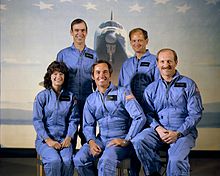STS-7

Challenger as photographed by the SPAS-1 satellite on June 22, 1983
|
|
| Mission type | Satellite deployment Microgravity research |
|---|---|
| Operator | NASA |
| COSPAR ID | 1983-059A |
| SATCAT no. | 14132 |
| Mission duration | 6 days, 2 hours, 23 minutes, 59 seconds |
| Distance travelled | 4,072,553 kilometres (2,530,567 mi) |
| Orbits completed | 97 |
| Spacecraft properties | |
| Spacecraft | Space Shuttle Challenger |
| Launch mass | 113,025 kilograms (249,177 lb) |
| Landing mass | 92,550 kilograms (204,040 lb) |
| Payload mass | 16,839 kilograms (37,124 lb) |
| Crew | |
| Crew size | 5 |
| Members |
Robert L. Crippen Frederick H. Hauck John M. Fabian Sally K. Ride Norman E. Thagard |
| Start of mission | |
| Launch date | June 18, 1983, 11:33:00 UTC |
| Launch site | Kennedy LC-39A |
| End of mission | |
| Landing date | June 24, 1983, 13:56:59 UTC |
| Landing site | Edwards Runway 15 |
| Orbital parameters | |
| Reference system | Geocentric |
| Regime | Low Earth |
| Perigee | 299 kilometres (186 mi) |
| Apogee | 307 kilometres (191 mi) |
| Inclination | 28.3 degrees |
| Period | 90.6 min |
 L-R: Ride, Fabian, Crippen, Thagard, Hauck |
|
STS-7 was NASA's seventh Space Shuttle mission, and the second mission for the Space Shuttle Challenger. During the mission, Challenger deployed several satellites into orbit. The shuttle launched from Kennedy Space Center on June 18, 1983, and landed at Edwards Air Force Base on June 24. STS-7 was notable for carrying Sally Ride, America's first female astronaut.
STS-7 began on June 18, 1983, with an on-time liftoff at 7:33 am EDT. It was the first spaceflight of an American woman (Sally K. Ride), the largest crew to fly in a single spacecraft up to that time (five people), and the first flight that included members of NASA's Group 8 astronaut class, which had been selected in 1978 to fly the Space Shuttle.
The crew of STS-7 included Robert L. Crippen, commander, making his second Shuttle flight; Frederick H. Hauck, pilot; and Ride, John M. Fabian and Norman Thagard, all mission specialists. Thagard conducted medical tests concerning Space Adaptation Syndrome, a bout of nausea frequently experienced by astronauts during the early phase of a space flight.
Two communications satellites – Anik C2 for Telesat of Canada, and Palapa B1 for Indonesia – were successfully deployed during the first two days of the mission. The mission also carried the first Shuttle Pallet Satellite, SPAS-1, which was built by the West German aerospace firm Messerschmitt-Bolkow-Blohm. SPAS-1 was unique in that it was designed to operate in the payload bay or be deployed by the Remote Manipulator System (RMS) as a free-flying satellite. It carried 10 experiments to study formation of metal alloys in microgravity, the operation of heat pipes, instruments for remote sensing observations, and a mass spectrometer to identify various gases in the payload bay. It was deployed by the RMS and flew alongside and over Challenger for several hours, performing various maneuvers, while a U.S.-supplied camera mounted on SPAS-1 took pictures of the orbiter. The RMS later grappled the pallet and returned it to the payload bay.
...
Wikipedia

